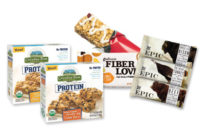Hotter, bolder, bitterer are some of the trending flavor characteristics seen in newly launched confectionery and snack products. Compared with last year’s flavors — maple syrup, nuts and honey — these flavors seem dialed-up, in your face, not unlike our raucous political climate.
And this year there is much more flavor name calling! The product’s primary flavor ingredient is being outed. Labels now shout, “Made with Meyer lemon” or “blood orange”; sweeping away yesteryear’s bland “Made with natural flavors” announcement. It’s as if candy and snack makers, like pollsters, are drilling down into their product’s DNA, providing its hometown provenance and assuring us of its clean, virtuous upbringing.
But that is what consumers are looking for in their choice of candy and snack candidates. Tired of Big Food’s spin room pitches, they want to know exactly what they are eating and that their choice might offer added benefits.
Is the industry responding to consumer sentiment for clean, clear and sometimes organic labels? You bet. Here are some typical responses.
“We are seeing significant interest in our flavor portfolio given the growing consumer demand for authentic, natural flavors,” notes Donald Wilkes, president of the natural flavor and ingredient company Blue Pacific Flavors. “This portfolio is based on our unique geographical access to the fresh fruits material supply chain so we can create natural flavors with whole fruit extractives as the primary ingredient.”
At IFC Solutions, a leading supplier of natural and organic ingredients, President David Dukes reports “We are seeing a significant amount of interest from existing and prospective customers across our entire product line.” To meet this demand, the company recently released organic sunflower lecithin and non-GMO / identity preserved soy lecithin, both products in liquid and powder form.
In addition to the stampede to clean labelling, what flavors seem to be trending?
Each year, I put this question to leading flavor houses, whose research serves as oracles for divining tomorrow’s new confectionery and snack products. I also interview key industry ingredient suppliers, retailers and gurus to get a cross-section of views and opinions.* From all this guidance, which is sometimes contradictory, I distill out those mega-trends that I believe will or currently are influencing new product development.
My list this year contains eight trends: hot & sassy, citrusy, bold, bitter, some world cuisine hot spots, salty, coconut and smoked. For added reader enjoyment, I included several flavors that have matured to middle-aged usage or could be relegated to the ash heap of yesterday’s news.
A special thanks to these companies for kindly contributing their time and expertise to my research: Bell Flavors, Blue Pacific, Firmenich, FONA International, Givaudan, IFC-Solutions, Kalsec, SaltWorks, Sensient Flavors and Symrise. Also Mark Christian (C-Spot), Paul Edward (Chef Rubber), Lior Lev Sercarz (La Boîte) and Mark Bitterman (The Meadow).

1. Hot and Sassy
Consumer interest in hot and spicy flavors remains, well, hot.
Chili pepper in chocolate is “still on trend,” according to Innova Market Insights, growing 22 percent for new launches this past year.
Some food pundits credit this feat for heat on the meteoric popularity of Sriracha, which encouraged chefs to scour the globe for other assertive spicy blends, an outcome dubbed “the Sriracha effect” by Technomic.
Measuring the growth and intensity of this trend was the object of a survey sponsored in 2015 by Kalsec, an industry leader in developing heat management products from natural sources. Some of the top-line survey findings were: 80 percent of respondents reported enjoying hot and spicy foods. Two out of five respondents agree than foods tastes better with some level of heat and that 1 in 4 admit eating spicy foods more often than they did one year ago. Snacks were the most popular new hot/spicy product tried in the past year.
Responding to consumer demand for bolder and more complex sources of pungency, Kalsec has extended its line of clean label, expeller-pressed specialty peppers by adding pasilla (tangy and mildly spicy with woodsy earth undertones), guajillo (earthy, paprika-like tobacco flavor with fruity undertones) and ghost pepper (intense pungency with slight smoke and hint of sweetness) extracts.
Another newish derivation on the heat-seeking flavor trend is combining heat (pungency) with a contrasting savory flavors resulting in multiple layers of taste experience. A popular example involves pairing chili pepper varietals with citrus or herbs to create hot and sassy flavor notes. This pairing is included in the 2016 McCormick’s Flavor Forecast under the heading “heat and tang” in which “spicy finds a welcome contrast with tangy accents — lime, rice vinegar, yuzu, tamarind, Meyer lemon, cranberry, kumquats and ponzu — to elevate the eating experience.” The report provided these examples: Peruvian chilies plus lime; and citrus paired with rocoto, aji panca and aji amarilla chili peppers.
Kalsec’s new Fusionary Heat flavor line was built around the hot and sassy theme. Senior Account Manager Al Kreitner identified three Fusionary Heat flavors receiving an “aggressive level of interest” by snack and confectionery manufacturers: Cardamom Citrus Heat, Smooth Lime Heat and Spiced Habanero.
As Sriracha moves to mainstream and consumers seek the next big flavor, Technomic has identified Korean gochujang and North African harissa, sumac and dukka as likely spicy blend candidates in its 2016 Trends report.

2. Citrus
Citrus flavors seem to be appearing everywhere. On restaurant dessert menus, lemon-flavored desserts ranked ninth in popularity, according to the National Restaurant Association’s What’s Hot 2016 Culinary Forecast. In fragrances, bergamot orange has inspired a rash of new perfume aromas, such as Diana Vreeland’s Vivaciously Bold (“… an audacious cocktail of citrus zests,” gushes the marketing material), Atelier Cologne’s Bergamote Soleil (bergamot paired with lavender and oak moss) and Matlin & Goetz’s unisex scent (paired with cardamom, ginger and black pepper).
As with chili peppers, the type of citrus is often called-out on packaging. Two trending fruits are grapefruit and pummelo, according to Givaudan’s Senior Food Scientist Cynthia Angelo.
Angelo should know her fruit. Givaudan, an early recognizer of the popularity of citrus, developed for its customers ten years ago the TasteTrek Citrus Program. The program invites its customers to explore some of the world’s most interesting citrus groves. “With citrus development centers on every continent, we work with customers in their markets to optimize profiles and build stability and sustainability into their products,” Givaudan’s regional Commercial Head of EAME Henning Hartnacke was quoted as saying in FoodIngredientsFirst.com.
To celebrate its decade old effort, Givaudan released in March the 10th Anniversary Global Citrus Flavor Collection, a collection curated from past TasteTreks. Included in this collection are Oroblanco Grapefruit, Valentine Pummelo, Variegated Pink Fleshed Eureka Lemon and Marsh Grapefruit (US); Lemon Femminello, Castagnaro Bergamot and Fiorentina Lemon (Italy); Delhi Lime and Kondan Seedless Lemon (India); Ponkan Mandarin and Meiwa Kumquat (China); Sakurajima Mikan (Japan); Sanguinelli Blood Orange (Spain); and Perão Sweet Orange (Brazil).
Inspired by citrus fruits found in California and Washington State farmers markets, Blue Pacific has added two flavors to its Farm Stand Natural Fruit Flavor portfolio: Meyer Lemon and Cuties Mandarin. The Cuties Mandarin product is also noteworthy as it involves a strategic partnership with the local grower and manufacturer of Cuties juices. Wilkes suggests that his citrus flavors will work well in fruit gummies and marshmallows.
FONA International‘s 2016 Flavor Insight Report: Blood Oranges highlights this fruit as having a uptick in 2015 North American new product launches. Although a majority of these applications were in beverage, some confectionery examples were offered in the report: Tory & Howard’s Chewie Fruities Blood Orange & Honey and Big Sky Brands’ Ginger Delights Blood Orange Candy Pastille. Blood orange was also featured in Bon Appetit (February 2016) and Rachael Ray (March 2016).

3. Pow! Zesty and bold
Confectionery and snack flavors are getting bolder and zestier, perhaps a culinary zeitgeist for our crazy political climate.
Zesty flavors provide a counterpoint to classic sweet flavors — brownie, peanut butter and chocolate chip — that have long dominated confectionery and snack products. This trend is driven both by flavor adventurous Millennials and consumers anxious to reduce their sugar intake.
Additionally, the use of zesty flavors helps mask bitter or insipid functional ingredients, such as protein powders and herbal extracts, to create a more enjoyable eating experience. McCormick calls this “blends with benefits” in its 2016 Flavor Forecast. “Flavorful herbs and spices add everyday versatility to good-for-you ingredients” and offers turmeric as an example. “Discover sweet possibilities when turmeric is blended with cocoa, cinnamon and nutmeg.”
Some recently launched examples of this trend in the snack bar category are Balance Bar’s bare Sweet & Spicy Nut bar and That’s It‘s Zesty, a new line of fruit bars that includes Apple Mango Chili and Apple Pear Ginger; and in chocolate, Patric Chocolate’s Triple Ginger chocolate bar with chunks of crystalized ginger, a 2016 Good Food Awards winner.
Zesty flavors are front and center in Saveur’s article on culinary flavor trends. Earlier this year, the magazine challenged Lior Lev Sercarz, a spice mixologist and owner of Manhattanbased spice emporium La Boîte, to design the “taste of 2016.” Borrowing from trending Middle Eastern and Mediterranean cuisines, Sercarz’ spice mixture includes Urfa chile (native to Urfa, Turkey), dried limes (a customary Omani ingredient) and nigella seeds (a popular condiment in Middle Eastern and Indian cuisine). He then combined these traditional spices with ingredients new to the culinary scene: coffee flour and powdered soy sauce and vinegar.
So, what does 2016 taste like?
”It tastes nutty and sour, with a hint of acidity and the perfect amount of heat,” Sercarz was quoted as saying. Sounds like a perfect description for our recent primaries.
As a side note, Sensient Flavors included Urfa chile in its 2016 Trends 2 Taste report. “From time to time, you come across something that is so luxe, it makes you feel special when you use it. This is one of those things.” The report describes Urfa chile’s taste as “rich, raisin-y, chocolate taste … [with] notes of tobacco and wine.”
A scenic detour on the hot and sassy candy and snack flavor highway is the use of pretty botanicals and flowers. Innova spotted a growing trend since 2011 in chocolate with herbs and spices. A good example is Vosges Haut-Chocolat’s newest collection, Les Fleurs du Chocolat truffles.
“When spring arrives, the world awakes in glorious bloom,” gushes the product description. Flavors include candied violets, nasturtium petals and marigold petals. And Chuao Chocolatier’s Enamored, a 72 percent organic dark chocolate collection including Raspberry Rose, Coconut Hibiscus and Blueberry Lavender. For gummies, FONA’s 2015 Category Insight Report: Gummies suggests the flavors ginseng, chrysanthemum, lemongrass and granadilla (a type of passion flower).

4. Bitter
Have American consumers grown bitter in their quest for the latest flavor?
Head to your favorite bar and you are sure to find a proliferation of bitter IPA craft beers on tap and amaros and bitters in cocktails. In fact, 13.4 percent of drink menus contain the descriptor “bitter,” according to Datassential’s MenuTrends,
While beverages are currently the most common application, the use of bitter flavors in candy and snacks offers significant benefits: the need for less salt and sugar.
“Bitter flavors offer a big mouthfeel and may provide enough flavor boost that consumers no longer need a salty taste as well,” explains Mintel’s Marcia Mogelonsky in an interview with FoodNavigator.
And less sugar. With a sales growth of 9 percent last year, the National Confectioners Association (NCA) selected bittersweet or dark chocolate as one of its confectionery trends for 2015. “But even within dark chocolate, the market is slowly shifting from dark to darker: 57 percent of shoppers said they will shift to a higher cocoa percentage when looking for healthier-for-you alternatives,” an association press release explained.
If you are looking for a healthier chocolate fix, why not switch from darker to darkest; that is, 100 percent cacao content bars? This is a niche that Mark Christian, the oracle of the chocolate blog C-Spot, calls “dark-brut.”
Who would want to buy dark-brut bars?
“Mainly guys wanting to get their antioxidants on,” Stéphane Bonnat told Christian. Apparently, there are a lot of guys with similar needs, for Chocolat Bonnat’s best-selling bar in the United States is its 100% Cacao Bar. Given that Chocolat Bonnat is arguable one of the best chocolate makers in the world, this sales factoid should carry some weight.
But aren’t dark-brut bars the same thing as baking chocolate of yesteryear; those hard blocks of bitterness made edible only by adding lots of sugar and baking them? Our craft chocolate makers, by jiggering roasting techniques and butter percentage, have transformed, like alchemists, these former bitter bars into hedonic elixirs.
That is, if executed properly; as it takes an amazing amount of skill, given that these bars stand naked, without sugar or other flavor additives, to cover up any sensory blemishes. In fact, Christian argues that there is no better gauge to evaluate a chocolate barsmith’s skill than to sample his/her 100% bar.
“It’s getting to the point now where any barsmith worth his or her salt… errrr, chocolate… [should] make a 100% [bar] to prove their mettle because, as we know, neither vanilla nor lecithin pack the obvious crutch for making chocolate; rather, it’s that spiced additive called ‘sugar’.”
Salty snacks are also experiencing a touch of bitterness. FONA’s 2016 Trend Insight Report on Snacks notes that “foodservice is seeing a proliferatif biflespecially on canvases like kale an vegetable chips that is expected t make its way into retail.”
Bitter gummies, too, might not be far behind, influenced by Americans fondness for such bitter brews as coldpressed coffee and iced tea. Even kombucha gummies are a possibility, adds FONA’s 2016 Flavor Insight Report: Gummies.
One can’t leave this discussion on bitter flavors without mentioning matcha. The Japanese green tea is included under the category “blends with benefits” in McCormick’s Flavor Forecast. “Matcha green tea and ginger and citrus balance the slightly bitter notes of matcha.”
Matcha flavored foods are popping up like little mushrooms after a spring rain. New gum launches include Hager Pharma’s Green Tea Chewing Gum, Bissinger’s Apricot Green Tea Gummies and Xlear’s Spry Dental Defense with green tea. In chocolate, Guylian’s Matcha Green Tea Seahorse Truffles has made its debut.

5. World Cuisine Hot Spots
What global cuisines are trending for food explorers?
McCormick’s Flavor Forecast includes “tropical Asia” — especially Malaysia and Philippines — with the explanation that “adventurous palates seek flavors from new regions ... for vibrant fare.”
According to Bell Flavors & Fragrances’ 2016 Spark Trends report, some culinary destinations of note are India and Cuba. Why India? “The contradicting and intoxicating flavors of India tease with their allure of spice, warmth, cool and freshness.” Curryflavored chocolate (e.g., Theo Chocolate’s Coconut Curry, Vosges Haut Chocolat’s Naga Bar and Patric Chocolate’s Red Curry bars) and snacks (Masala Pop’s Saffron Rose popcorn, a 2015 SOfifinalist) are appearing more frequently in the U.S. marketplace.
The selection of Cuba was based upon warming relations between that island nation and the United States. But taking a wider American culinary lens, the Hispanic market continues to grow in importance. Demographers in the U.S. Census Bureau project that our Hispanic population will increase 57 percent to 106 million by 2050. As for their purchasing clout, in 2014 it was estimated at $1.25 trillion by the Selig Center for Economic Growth.
Symrise’s Flavor Marketing & Consumer Insight’s group has been studying this market for years. Explains Ian Thurston, senior marketing communications manager, Symrise — North America in an email:
“Symrise looked at tropical taste innovations as part of our in-depth research that evaluated the ways that Latinos are changing the way America eats. We saw increasing opportunities to feature tamarind, guanabana, hibiscus, horchata, papaya, guava, mango, passion fruit as well as more familiar tropical tastes, such as pineapple, coconut, fidarin and tangerine, especially for y and dessert products.” , too, has jumped into this market and ed earlier this year a new line of Mexican flavors. “We have worked on a flavor range that captures the true characteristics of the Mexican palate and lifestyle and brings it to [European] consumers,” says Stefano Asti, technical director at Sensient Flavors Beverage Europe in an interview with FoodIngredients-m. Sensient flavors include horchata, & cactus, chili & mango and strawberry & guava.
Blue Pacific, for its part, has a line of Latino Tropical Flavors and offers Mexican Tamarindo and Horchata.
Catering to Angelinos’ flavor preferences, Mast Brothers’ new Los Angeles chocolate factory offers bonbons flavored with mezcal, cilantro & lime, pink lemon and jalapeno.

6. Salty
The all-natural sea salt category is huge and continuing to grow, and plays into the clean label, natural foods and healthier foods trend across the culinary and confectionery category spectrum, says Megan O’Keefe, SaltWorks’ chief salt ambassador. Salt can add a bright note to the product, not only in flavor but also in color and texture.
People are becoming more experimental in their sea salt use, says O’Keefe. Single origin salts, like Himalayan Pink, and naturally flavored salts have gained a lot of popularity due to their more sophisticated flavor pairings and simplicity of application for an impactful flavor and textural punch. “You don’t need much to get a big flavor pay off, especially when used as a topping or inclusion in chocolates and confections.”
So what flavors are trending in salt?
Among global launches of premium chocolate, sea salt flavored products jumped 350 percent in a 12-month period ending March 2016, according to FONA’s 2016 Category Insight Report: Chocolate Confectionery.
One of SaltWorks’ top selling gourmet sea salts in the confectionery industry is Artisan Fleur de Sel from France. It was the first gourmet salt to come on the food radar and is still a mainstay ingredient, especially for topping caramels and chocolate bars. Ancient Ocean Himalayan Pink is also a bestseller, available in a wide variety of grain sizes to customize a confection’s texture and flavor experience. A smaller grain version can be used as a topping or as an inclusion to add crunch. It’s a dense salt that holds up nicely. Also popular in this category are the Hawaiian salts, Alaea (red) and Hiwa Kai (silky black), which add both crunch and a beautiful visual dynamic to a confection.
SaltWorks’ six bestselling naturally flavored salts in its Fusion line for confections are Black Truffle (also their all around top seller in this line—a traditionally savory flavor but it’s showing up in honeys, caramels and sweeter applications), Habanero, Vanilla Bean, Thai Ginger (especially popular with white chocolate applications), Vintage Merlot (a subtle merlot flavor but also adds a bright maroon color visual when used as a toppings) and Espresso Brava (adds a savory coffee-flavored note in chocolate or caramel applications). O’Keefe adds that Sriracha and Spicy Curry (used in chocolate bars) are wild cards that are showing up in sweeter applications as the market for experimental flavors in this category continues to grow.

7. Coconut
Coconut, driven by the popularity of coconut water, was named “Flavor of the Year” by Firmenich. “… the appeal of coconut lies in consumers’ attraction to the feelings of balance and well-being that coconut evokes. [It] is also a great team player, happy to take a supporting flavor role,” the company noted in a press release.
Coconut is certainly happy to play in chocolate’s space. Coconut claims jumped 500 percent, making it the most popular flavor in global premium chocolate launches during the 12-month period ending March 2016, according to FONA’s 2016 Category Insight Report: Chocolate Confectionery. While coconut oil was identified as an ingredient of interest in nut butters by New Hope Media’s NEXT Trend Product Concept Lab (posted May 11), citing its “immune-boosting” properties.
Two U.S. candy and snack companies specializing in coconut are Dang Foods (toasted coconut chips) and JJ Sweets Cocomels (coconut milk caramels). While Chuao Chocolatier’s new Enamored collection features a dark chocolate (72%) organic Coconut Hibiscus bar.
8. Smoked
Smoked sea salts remain popular in innovative confectionary flavor pairings. As with peppers and citrus, the type of smoked wood is being called out and highlighted. SaltWorks’ O’Keefe notes the top three popular flavors for chocolatiers being alder wood (Salish), which she described as having a nice balanced flavor intensity, one that isn’t overpowered by the chocolate/ confection as well as being available in a range of grain sizes to allow chocolatiers to customize the texture and flavor experience; Robusto (a flake salt; smoked with a blend of seven woods, has a full well-balanced flavor; works well with topping caramels or truffles); and apple wood (Yakima) that works well with lighter flavors, a more mild smoke and delicate flake texture and flavor.
The next stop on the smoky flavor trail might be charred or fire roasted. It’s on Technomic’s list of 2016 trends. What’s the point of scorched ingredients?
According to a Wall Street Journal story (December 23, 2015) , Master the Art of Vegetables That Are ‘Burnt,’ Never ‘Burned’, charring “conveys ‘authenticity,’ with flaws like black spots and seared edges that consumers perceive as more real, homemade and healthy than food processed to perfection.”
Popping up on menus with increasing frequency are charred veggies like Brussel sprouts, kale and asparagus; or tomatoes for salsa and fruit peels for cocktails. Even charred coconut, a flavor that Sensient Flavors includes in its 2016 Trends 2 Taste report. There seems to be no limit in what chefs can do with their repurposed kitchen blowtorches.
Yesterday’s flavors
The National Restaurant Association’s What’s Hot 2016 Culinary Forecast listed two flavors relevant to our industry as having had been kicked to the curb: insects (ranked first as yesterday’s flavor) and bacon-flavored/covered chocolate (ranked fourth). FONA’s 2016 Flavor Radar includes bourbon, curry, blood orange and habanero as four flavors that have evolved into everyday usage.
In summary, there is an incredible spirit of innovation sweeping our confectionery and snack industries. New product development is being influenced more than ever by smaller brands, many of them artisan or craft. While entry into our industry used to be expensive, now the availability of economically priced equipment and assortment of willing co-packers allow folks with a passion to get started on budgets fit for write-in candidates. Additionally, the rising prominence of social media and alternate distribution channels provides “third party” direct access to consumers, side-stepping traditional marketing avenues entrenched by legacy brands.
As an example, while spotting trends at expos like the Fancy Food Show, I am amazed at how many novice exhibitors with breath-taking new products received their initial funding from Shark Tank or cloud-sourcing.
Lastly, as we continue to expand our culinary tent to include our many, vibrant ethnic communities, we will be rewarded by an ever-expanding palate of taste travels.
Curtis Vreeland, president of Vreeland & Associates (www.vreelandassociates. com), specializes in confectionery and snack market research/analytics. He has been spotting trends in the premium confectionery and snack sectors for Candy Industry Magazine for years.







